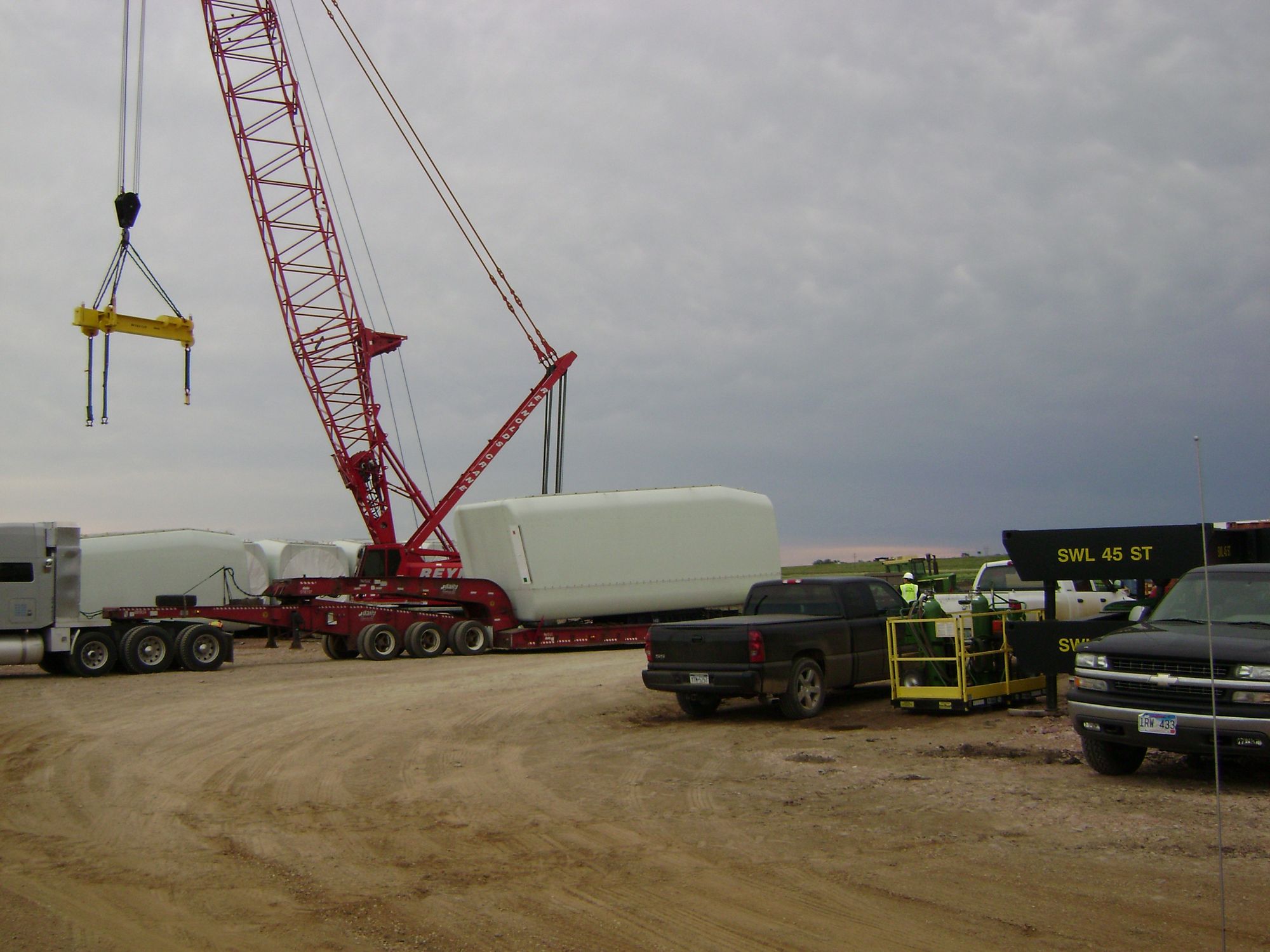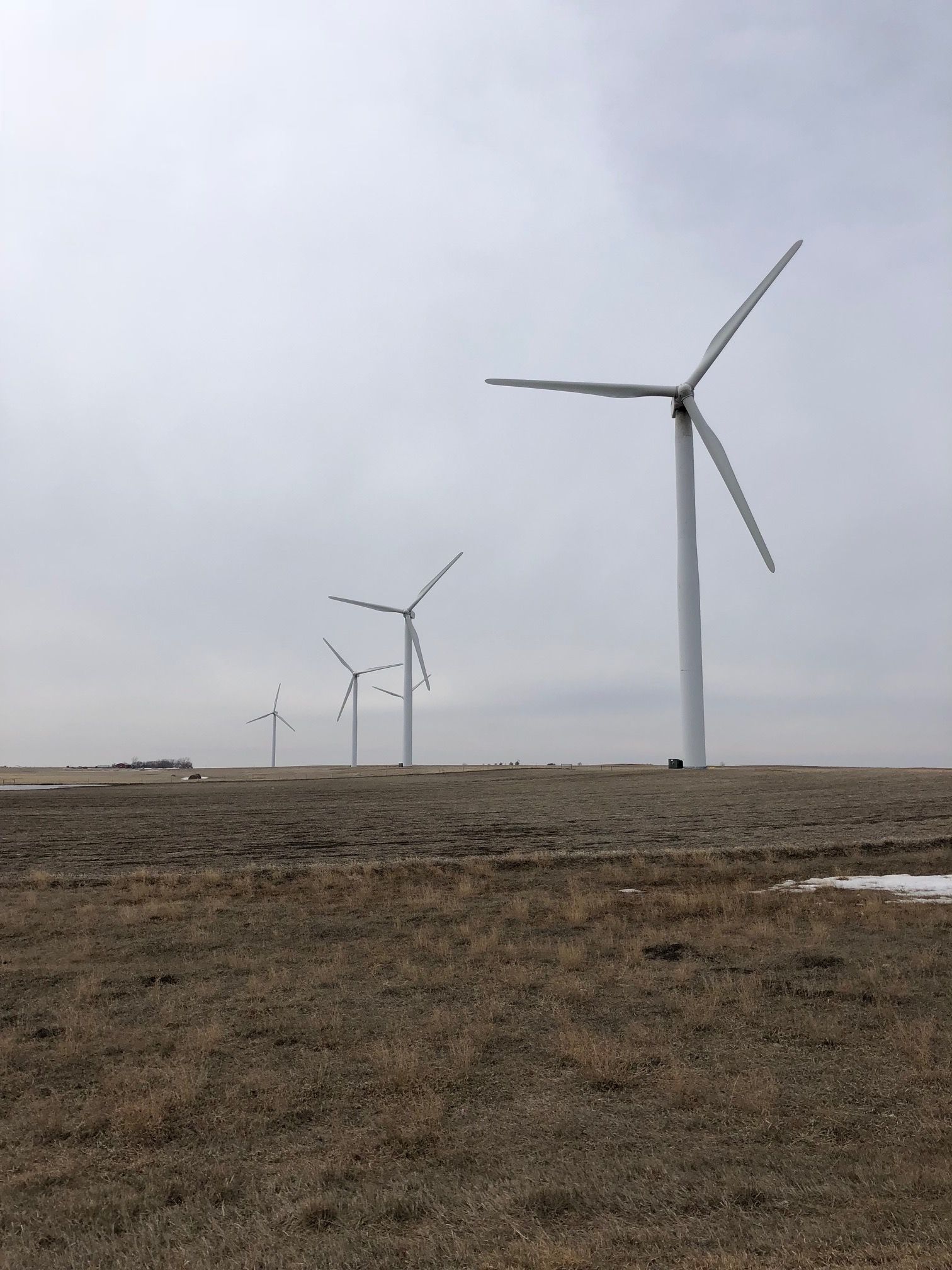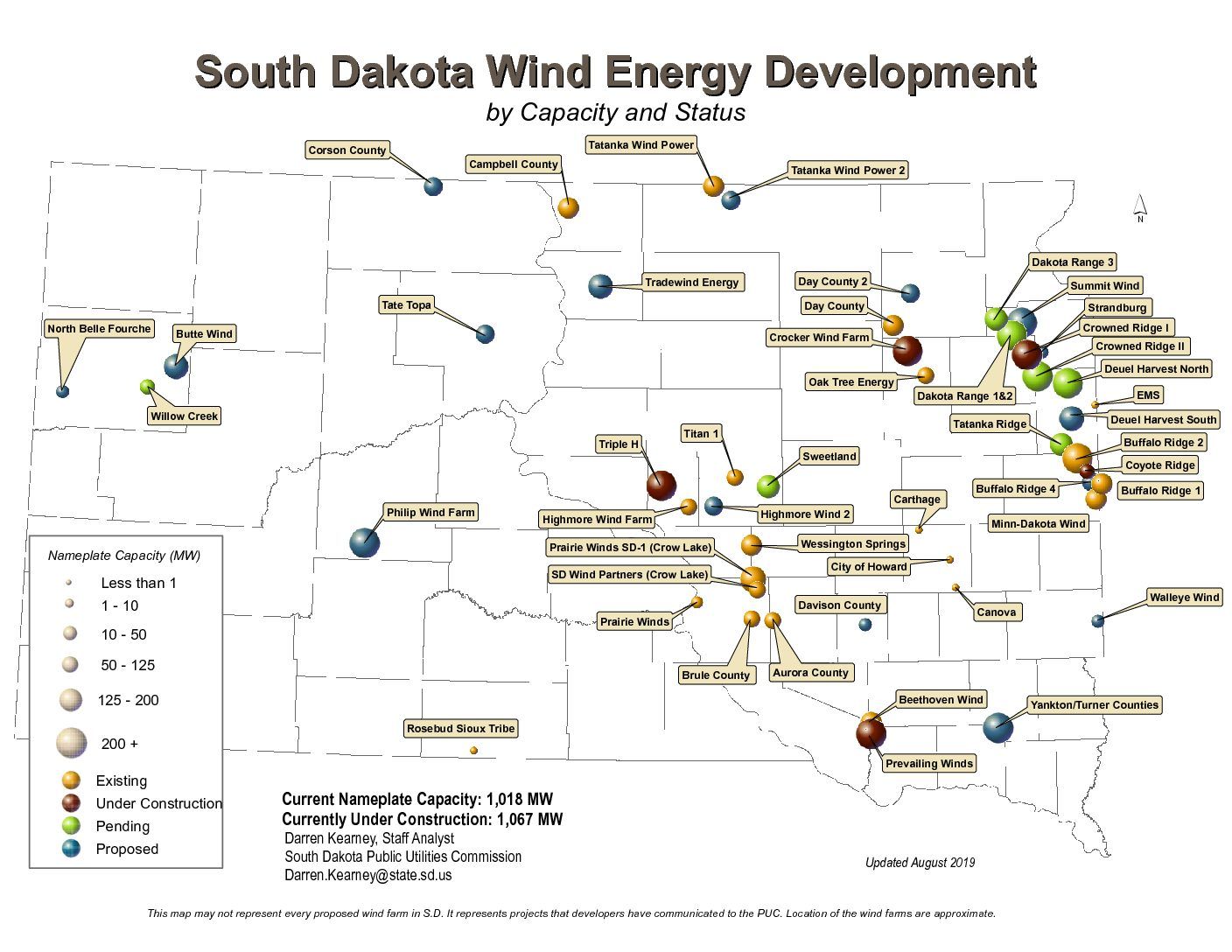The prairies and rolling hills of South Dakota will soon become dotted with wind turbines after the approval of eight major wind-energy projects that will bring 700 more turbines and an investment of $2.6 billion in the state by the end of 2020.
Two other projects now in the regulatory approval process would bring 188 more turbines and another $640 million in investments to the state, bringing the total of new turbines to 888 and the investment by energy companies to $3.26 billion.
The rapid expansion of wind energy will reach across the state, with the majority of new turbines targeted for the northeast corner, but with other projects planned in Hand and Hyde counties in the center of the state and one 45-turbine project now under construction near Newell in Butte County in the far northwest.
Just two years ago, despite being home to the third-most-active winds in the nation, South Dakota ranked No. 19 for wind-energy production among the 50 states, with 15 wind farms and a total of 584 turbines able to generate 1,014 megawatts of electricity.
New national ranking data is not yet available, but the approved and docketed projects would raise the total of wind farms to 25 and nearly triple the number of wind towers in the state. The electricity-production capacity would rise to more than 3,600 megawatts. Though it is variable, one megawatt of electricity can power about 1,000 homes; South Dakota ranks third in the nation for the number of homes, about 300,000, that are powered by wind energy.
Any new energy project is subject to extensive review and typically draws significant opposition. Most of the new wind farms approved for construction in South Dakota faced questions by neighbors about the impacts of 500-foot tall towers, noise and light flicker from rotors that operate in a 380-foot diameter, and the potential effects on property values and local birds and wildlife.
Those who support renewable energy and the economic benefits of new industry, however, are exuberant over the spate of new wind farms approved for construction. The eight project approvals all came between June 2018 and July 2019.
“For rural South Dakota, this is an awesome boom,” said Steven Wegman of the South Dakota Renewable Energy Association. “No one ever spent $300 million in Codington County in a construction season.”
Landowners, local governments and schools will all see significant financial benefits from the projects. One wind farm approved in Clark County, the Crocker Wind Farm, will pay leaseholders $46 million over the next 20 years, according to documents filed by developer Geronimo Energy. That project, which includes up to 120 turbines and an expected investment of $600 million, will also create 10-20 full-time jobs, support a “community fund” of $1.6 million, and generate $36 million in tax revenues for the state, county, township and local schools in its first two decades of operation.
Many people who travel on Interstate 90 across South Dakota have undoubtedly obtained an up-close view of the ongoing expansion of wind energy in the state after a pair of small wind farms came online last year. The Aurora Wind Farm, with nine turbines, began generating electricity in Aurora County south of the interstate in October 2018.
That same month, the Brule Wind Farm began generating electricity with nine turbines that are clearly visible south of the interstate near Kimball. Those projects were the only significant wind farms to begin operation in South Dakota from January 2016 to October 2018.
Nearly 900 more wind turbines coming to SD
Here is a glance at the eight wind-energy projects that received approval for construction in South Dakota from the Public Utilities Commission between June 2018 and July 2019, along with two others (**) now under consideration. Projects are listed chronologically by approval date and with location county or counties. Most projects have a completion date of sometime in 2020, though some may be completed in late 2019.
Crocker Wind FarmClark County, 120 turbines, 400 MW, $600 million
Dakota Range Wind ProjectGrant/Codington, 72 turbines, 302 MW, $380 million
Prevailing Wind ParkBon Homme/Charles Mix/Hutchinson, 61 turbines, 220 MW, $100 million
Dakota Range IIIGrant/Roberts, 42 turbines, 151 MW, $200 million
Deuel Harvest North Wind FarmDeuel, 112 turbines, 310 MW, $400 million
Crowned Ridge Wind FarmGrant/Codington, 130 turbines, 300 MW, $400 million
Triple H Wind ProjectHyde, 92 turbines, 251 MW, $300 million
Sweetland Wind FarmHand, 71 turbines, 200 MW, $240 Million
Crowned Ridge II**Codington/Deuel/Grant, 132 turbines, 301 MW, $425 million
Tatanka Ridge**Deuel, 56 turbines, 155 MW, $216 million
Totals: 888 turbines, 2,590 MW, $3.26 billion
Information from S.D. PUC; project costs may include construction, taxes and landowner payments; megawatt listing is for maximum electricity-generation capacity. Projects with asterisks (**) are now under consideration by the PUC.
Stage is set for wind energy in SD
Several factors have led to the rapid expansion of wind-energy projects since then.
Wind-energy developers are rushing to bring projects online as quickly as possible to obtain the significant financial benefits of the Renewable Electricity Production Tax Credit for new wind projects. The U.S. Congress has voted to begin phasing out those credits starting in 2020 and ending in 2025. The 10-year tax credit remains a major driver of new wind projects across the United States.
The rush to obtain the full value of those tax credits has dovetailed with the recent completion of two 345-kilovolt power lines that created new capacity to move electricity produced in South Dakota and North Dakota to markets in neighboring states, particularly to the energy-hungry metroplex of Minneapolis. The two new lines now extend from Ellendale, N.D., to Brookings, S.D., and can then carry energy on a separate line to the Twin Cities area.
In advance of those projects, South Dakota lawmakers in 2015 approved a measure to reduce the state tax on production of each kilowatt of wind energy by roughly a third.
The other factors driving the wind-energy expansion are an increased push by many states to encourage or require further usage of energy from renewable resources, and a dramatic decrease in the cost of harnessing wind energy. In the early 2010s, it cost energy companies about $3,500 to build turbines and machinery to harness a kilowatt of electricity. Due to advancements in design and maturation of the industry, that cost has fallen below $2,000 per kilowatt of capacity, Wegman said.
In recent years, South Dakota lawmakers and officials have tried to lure wind-energy companies to the state, where the wind blows at full capacity about 40% of the time, the third-highest rate in the nation. Suddenly, the state has the full attention of energy companies that see South Dakota as a viable place to make money off the wind.
“It’s about time; we’ve been in the wading pool for a long time, and now the tide has come in,” said Wegman. “A lot of small towns and counties and townships are going to get an economic boost that they’ve never, ever had since South Dakota became a state.”

Arduous, imperfect approval process
The approval process for new wind farms is arduous and can take years and cost energy companies several million dollars in up-front costs.
Eight major wind projects were approved in a 13-month period by the South Dakota Public Utilities Commission, an incredible pace for the three-member elected board that reviews and rules on energy-construction projects and also regulates utility rates.
For regulators, the past 15 months have been a whirlwind of reviewing construction plans and siting documents and sifting through arguments both for and against the projects, said Gary Hanson, chair of the PUC.
Hanson said a legislative change last year that granted regulators nine months instead of six months to consider energy projects helped the agency but did not totally alleviate the feeling of being rushed.
“There’s a lot of adjectives to describe it, some of them good and some of them bad,” Hanson said. “It’s been very hectic with wind development, and to have all those projects on top of each other is like having five kids in college at the same time.”
Hanson said the PUC, the developers and local officials and residents have worked hard to reduce the impacts of the wind farms and turbines.
Several of the approved projects have dozens of conditions placed upon developers in response to concerns or complaints levied by local officials and neighbors of the projects. Counties where wind farms will be built have control over some siting issues, including the critical matter of setbacks that determine how close towers can be to roads, neighboring homes or municipal boundaries.
Hanson said the PUC tries to develop precedents that can guide developers and locals in how to approach contentious issues. Hanson said no process is perfect and that he understands that some people don’t want a wind tower in their neighborhood. He said the PUC is bound to follow state laws and regulations and that if a developer meets all the requirements, the PUC is bound to approve a qualifying project.
For example, Hanson said the PUC approved the Brule wind farm even though he now feels that the towers are too close to I-90, which he said was a county and not a state decision.
“It’s not always the way we want it,” Hanson said. “We may love something or we may hate something, but in the end we have to vote based on what the law tells us to do.”
Hanson said the big burst of new wind projects may have subsided. But Hanson said he has heard that more projects are in the discussion stage and that he expects the PUC may soon place more wind farms on its docket of projects to review.

Wind energy brings economic benefits
There is no guarantee that all of the approved or docketed projects will be built, as some projects can change hands or suffer from capital deficits, but those who know the wind industry believe most South Dakota projects are likely to move forward. Also in question is whether energy firms will use South Dakota contractors and suppliers to support construction and maintenance of the wind farms.
However, the rapid growth in wind-energy production is welcome news for the eight South Dakota companies that provide equipment, support and maintenance services to wind-energy developers and operators, said Mike Sherman, president of Renew Energy Maintenance in Sioux Falls.
“It definitely benefits our company and creates opportunities for us to add employees,” Sherman said.
Renew aids in construction of wind-energy projects but mostly on a smaller scale than the size of the wind farms coming to South Dakota, Sherman said. But after the South Dakota projects are up and running, Renew may see a financial and employment boost by providing maintenance services.
“We don’t do a lot of new construction work, but we travel all over North America doing maintenance,” Sherman said. “For us, it’s nice to be finally be able to do work in our home state.”
Renew is often called on to help wind-energy companies to perform quality-control efforts and reduce continuing costs of operation, Sherman said.
Renew, which now has about 260 employees, operates from offices on East River Ridge Place just northeast of the intersection of 26th Street and Interstate 229 in Sioux Falls.
Even with the rush of new wind projects, finding new employees may be a challenge, however. Like many technology-based firms in South Dakota, Renew has a hard time recruiting qualified workers. Sherman said the company has a representative on the advisory board at both Mitchell and Lake Area technical institutes in its efforts to cultivate its workforce.
“With the economy being good right now, if we could find the right people, we could hire another 30 to 40 employees today,” he said.
Sherman said the projects should also provide a big boost to rural counties across the state.
“It’s absolutely good news and a real big boost to local economies,” Sherman said. “It creates jobs in rural areas and significant tax benefits that come to the counties though construction and operations.”
Even though the projects will generate significant property taxes for several rural counties in South Dakota, not all local officials are excited about the wind farms.
Deuel County Commission Chair Steve Rhody said he is reserving judgment on the potential long-term outcomes of the Deuel Harvest North Wind Farm, which has been approved to build up to 112 turbines in the eastern side of the county by 2020.
According to filings with the state by developer Invenergy, the project will cost $400 million to build, create 400 temporary and 15 permanent jobs, generate $87 million in payments to landowners and result in $40 million in tax payments to state and local governments over the 30-year life of the project. The company predicts it will pay $23 million in wages and benefits to local employees during that time.
Deuel Harvest is one of two new wind-energy projects that may be partially or fully sited within Deuel County in the coming years.
Rhody said that outside of those who will receive lease payments, the project was not supported by many residents of the county, including several who testified against it during public hearings.
“I know that we will make more money,” Rhody said. “But it’s not going to be all good. They’re going to wreck some roads and it’s going to be really busy until it gets totally built.”
Rhody said he understands that the wind projects are seen as a benefit to the state, and that state economic officials are excited about the potential windfalls.
“They’ve been going wild over it, but of course, they aren’t living underneath them,” Rhody said. “Lots of people who are opposed to them, and I’m kind of reserving judgment,” he said. “Time will tell how it turns out.”

This map, updated as of January 2018, shows the size and location of existing and proposed wind farms in South Dakota, though not all of the projects that were recently approved by the state PUC are shown. A larger version can be accessed through this LINK.




